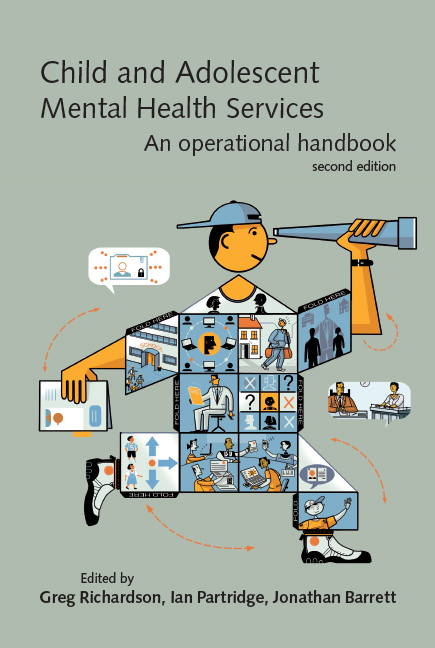Book contents
- Frontmatter
- Contents
- Tables, boxes and figures
- Contributors
- Abbreviations
- Preface
- 1 Introduction
- 2 CAMHS in context
- 3 CAMHS and the law
- 4 Structure, organisation and management of CAMHS
- 5 Evidence-based practice
- 6 Clinical governance
- 7 Education, supervision and workforce development
- 8 Multidisciplinary working
- 9 User and carer participation and advocacy
- 10 A comprehensive CAMHS
- 11 Referral management
- 12 Demand and capacity management
- 13 Strategies for working with Tier 1
- 14 Structuring and managing treatment options
- 15 CAMHS in the emergency department
- 16 Paediatric liaison
- 17 Self-harm
- 18 Learning disability services
- 19 Services for autism-spectrum disorders
- 20 Attentional problems services
- 21 Eating disorder teams
- 22 Bereavement services
- 23 CAMHS for refugees and recent immigrants
- 24 CAMHS and looked-after children
- 25 Drug and alcohol teams
- 26 Parenting risk assessment service
- 27 Court work
- 28 Tier 4 options
- 29 In-patient psychiatric care
- 30 Forensic services
- 31 Neuropsychiatry and neuropsychology services
- 32 Mental health provision for deaf children: study of a low-incidence service provision
- 33 Chief Executives – what do they want and how do they get it?
- Index
21 - Eating disorder teams
- Frontmatter
- Contents
- Tables, boxes and figures
- Contributors
- Abbreviations
- Preface
- 1 Introduction
- 2 CAMHS in context
- 3 CAMHS and the law
- 4 Structure, organisation and management of CAMHS
- 5 Evidence-based practice
- 6 Clinical governance
- 7 Education, supervision and workforce development
- 8 Multidisciplinary working
- 9 User and carer participation and advocacy
- 10 A comprehensive CAMHS
- 11 Referral management
- 12 Demand and capacity management
- 13 Strategies for working with Tier 1
- 14 Structuring and managing treatment options
- 15 CAMHS in the emergency department
- 16 Paediatric liaison
- 17 Self-harm
- 18 Learning disability services
- 19 Services for autism-spectrum disorders
- 20 Attentional problems services
- 21 Eating disorder teams
- 22 Bereavement services
- 23 CAMHS for refugees and recent immigrants
- 24 CAMHS and looked-after children
- 25 Drug and alcohol teams
- 26 Parenting risk assessment service
- 27 Court work
- 28 Tier 4 options
- 29 In-patient psychiatric care
- 30 Forensic services
- 31 Neuropsychiatry and neuropsychology services
- 32 Mental health provision for deaf children: study of a low-incidence service provision
- 33 Chief Executives – what do they want and how do they get it?
- Index
Summary
‘How disenchanting in the female character is a manifestation of relish for the pleasures of the table!’
William Charles MacreadyIntroduction
What causes eating disorders and how they are best treated remains the subject of much debate (Royal College of Psychiatrists, 1992; Ward et al, 1995; Shoebridge & Gowers, 2000; Gowers & Shore, 2001; Steinhausen, 2002; Gowers et al, 2007). However, referral to CAMHS continues and the need for an effective service remains. The NICE guidelines (National Collaborating Centre for Mental Health, 2004) recommend psychological interventions primarily in an out-patient setting, naming CBT for bulimia nervosa and family involvement including siblings in the treatment of young people with eating disorders. Specialist services for these young people are increasing, particularly in the independent in-patient sector. The establishment of a Tier 3 team within a CAMHS makes effective use of resources, in terms of both personnel and time (Roberts et al, 1998). The principles that underpin the workings of such a team are set out in Box 21.1.
Eating disorders can present in a number of forms: anorexia nervosa; bulimia nervosa; atypical variations of both; eating disorders not otherwise specified; and other feeding problems or disorders in childhood, described by Nicholls & Bryant-Waugh (2009) as food avoidance emotional disorder, selective eating, food phobias, functional dysphagia and food refusal. Obesity, ironically, remains the result of the major eating disorder of our time – eating too much and exercising too little, but its management is not usually the province of an eating disorder team.
Anorexia nervosa is characterised by a fear of fatness and a preoccupation with food, in which reduction of caloric intake (vomiting may be used) and increase in energy output via exercise and/or forms of purging results in serious weight loss. It may commence prior to puberty, although this is unusual, and affects up to 1% of 15- to 20-year-olds, of whom 10% are male.
Bulimia nervosa is characterised by a fear of loss of control with regard to eating. It results in episodes of binging and vomiting, and a preoccupation with weight and diet. It is more common than anorexia nervosa but tends to develop later in adolescence.
- Type
- Chapter
- Information
- Child and Adolescent Mental Health ServicesAn Operational Handbook, pp. 200 - 206Publisher: Royal College of PsychiatristsFirst published in: 2017



